Refine search
Actions for selected content:
12661 results in History of science
6 - Niels Bohr's Interpretation of the Quantum Theory(1961)
- from Part One - Papers and Book Chapters(1948–1970)
-
- Book:
- Physics and Philosophy
- Published online:
- 05 October 2015
- Print publication:
- 17 September 2015, pp 74-98
-
- Chapter
- Export citation
Part Three - Encyclopedia Entries(1958–1967)
-
- Book:
- Physics and Philosophy
- Published online:
- 05 October 2015
- Print publication:
- 17 September 2015, pp 321-386
-
- Chapter
- Export citation
Introduction
-
- Book:
- Physics and Philosophy
- Published online:
- 05 October 2015
- Print publication:
- 17 September 2015, pp x-xxix
-
- Chapter
- Export citation
17 - Review of John von Neumann,Mathematical Foundations of Quantum Mechanics, translated from the German edition by Robert T. Beyer, Princeton: Princeton University Press, 1955(1958)
- from Part Two - Reviews and Comments(1957–1967)
-
- Book:
- Physics and Philosophy
- Published online:
- 05 October 2015
- Print publication:
- 17 September 2015, pp 294-298
-
- Chapter
- Export citation
Part Two - Reviews and Comments(1957–1967)
-
- Book:
- Physics and Philosophy
- Published online:
- 05 October 2015
- Print publication:
- 17 September 2015, pp 269-320
-
- Chapter
- Export citation
13 - On the Possibility of a Perpetuum Mobile of the Second Kind(1966)
- from Part One - Papers and Book Chapters(1948–1970)
-
- Book:
- Physics and Philosophy
- Published online:
- 05 October 2015
- Print publication:
- 17 September 2015, pp 234-238
-
- Chapter
- Export citation
11 - Dialectical Materialism and the Quantum Theory(1966)
- from Part One - Papers and Book Chapters(1948–1970)
-
- Book:
- Physics and Philosophy
- Published online:
- 05 October 2015
- Print publication:
- 17 September 2015, pp 219-224
-
- Chapter
- Export citation
23 - Review of Hans Reichenbach,Philosophic Foundations of Quantum Mechanics, Berkeley–Los Angeles: University of California Press, 1965(1967)
- from Part Two - Reviews and Comments(1957–1967)
-
- Book:
- Physics and Philosophy
- Published online:
- 05 October 2015
- Print publication:
- 17 September 2015, pp 318-320
-
- Chapter
- Export citation
Dedication
-
- Book:
- Physics and Philosophy
- Published online:
- 05 October 2015
- Print publication:
- 17 September 2015, pp v-vi
-
- Chapter
- Export citation
2 - Physics and Ontology(1954)
- from Part One - Papers and Book Chapters(1948–1970)
-
- Book:
- Physics and Philosophy
- Published online:
- 05 October 2015
- Print publication:
- 17 September 2015, pp 9-24
-
- Chapter
- Export citation
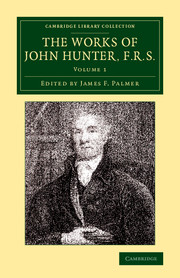
The Works of John Hunter, F.R.S.
- With Notes
-
- Published online:
- 05 September 2015
- Print publication:
- 26 March 2015
- First published in:
- 1835
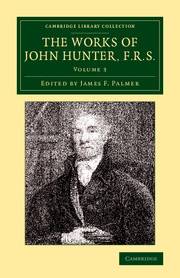
The Works of John Hunter, F.R.S.
- With Notes
-
- Published online:
- 05 September 2015
- Print publication:
- 26 March 2015
- First published in:
- 1837

The Works of John Hunter, F.R.S.
- With Notes
-
- Published online:
- 05 September 2015
- Print publication:
- 26 March 2015
- First published in:
- 1837
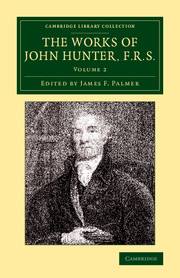
The Works of John Hunter, F.R.S.
- With Notes
-
- Published online:
- 05 September 2015
- Print publication:
- 26 March 2015
- First published in:
- 1835

The Vegetable Kingdom
- Or, the Structure, Classification, and Uses of Plants Illustrated upon the Natural System
-
- Published online:
- 05 September 2015
- Print publication:
- 05 March 2015
- First published in:
- 1847
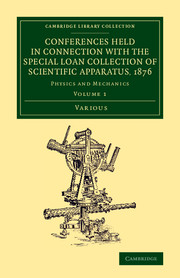
Conferences Held in Connection with the Special Loan Collection of Scientific Apparatus, 1876
- Physics and Mechanics
-
- Published online:
- 05 September 2015
- Print publication:
- 19 March 2015
- First published in:
- 1876

A Mathematical and Philosophical Dictionary
- Containing an Explanation of the Terms, and an Account of the Several Subjects, Comprized under the Heads Mathematics, Astronomy, and Philosophy, Both Natural and Experimental
-
- Published online:
- 05 September 2015
- Print publication:
- 29 January 2015
- First published in:
- 1796
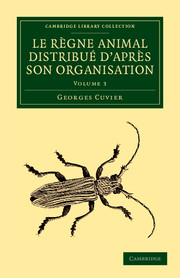
Le règne animal distribué d'après son organisation
- Pour servir de base à l'histoire naturelle des animaux et d'introduction à l'anatomie comparée
-
- Published online:
- 05 July 2015
- Print publication:
- 13 November 2012
- First published in:
- 1817
12 - From an Aesthetics of Everyday Life to Dilthey’s Lived Experience (1864–1868)
- from Part Three - The System in the Bismarck Period
-
- Book:
- Hermann Lotze
- Published online:
- 05 June 2015
- Print publication:
- 09 June 2015, pp 323-351
-
- Chapter
- Export citation
4 - A Gestalt Metaphysics: Laws, Events, and Values (1838–1841)
- from Part One - Youth in Biedermeier
-
- Book:
- Hermann Lotze
- Published online:
- 05 June 2015
- Print publication:
- 09 June 2015, pp 90-122
-
- Chapter
- Export citation
